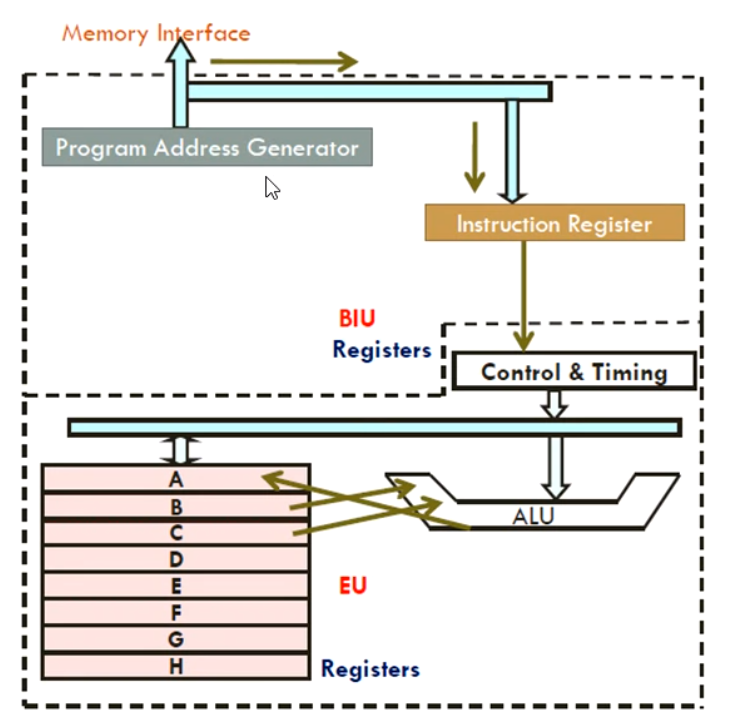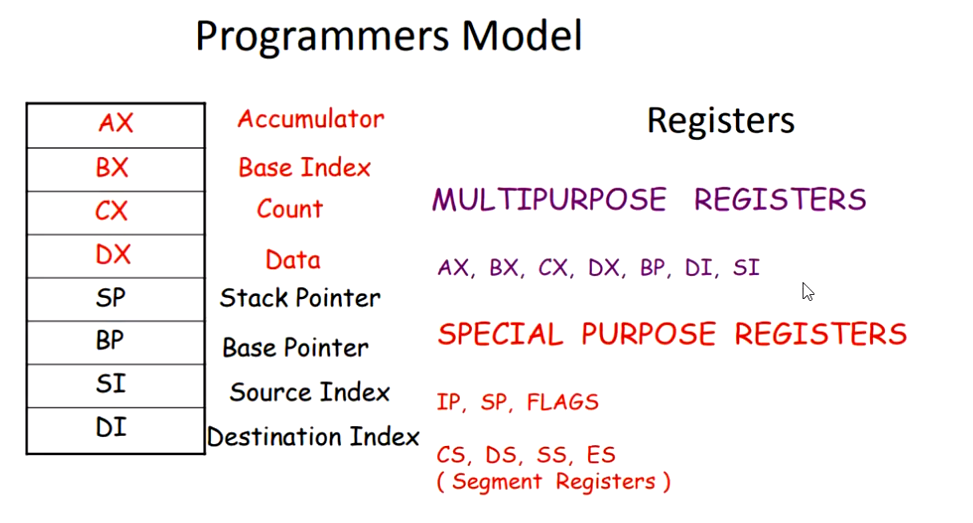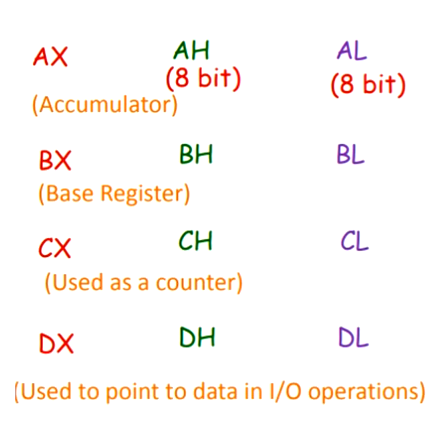01 Intro
What happens when we switch on computer¶
- BIOS(Basic Input Output System) loaded from the ROM(Read-Only Memory)
- BIOS loads OS into the RAM RAM should atleast be the size of the OS
- OS loads programs from disk to RAM Program: set of instructions executed by \(\mu p\)
What is an instruction?¶
Tells the MP what actions to perform
- operations
- logic
- arithmetic
- read data from input device
- write to memory
- reset
- stop
Assembly program gives these instructions. Each microprocessor understands these instructions in different ways.
High-level program use statements which get compiled/interpreted into machine language. Allows programmer focus on the logic, rather than worrying about how it will understood by the MP.
Microprocessor¶
has both sequential and combinational circuits
- Control unit has sequential circuits
- ALU has combinational circuits
Size of the processor = size of ALU
Instruction-Handling¶
Instructions is a set of command, used by the mp to perform to certain taks
- Fetch Instruction Instruction taken from the memory and stored in instruction register
- Decode Instruction
- Fetch Operand(s)
- Execute Cycle actions are performed
- Store result
Make this into block diagram
- BIU - Bus Interface Unit
- ALU - Arithmetic Logic Unit
- Execution Unit
Overview¶
Microcontrollers like Arduino have the memory also embedded to the processor

Detailed¶

Architectures¶
Instruction Set Architecture¶
This is the design/theory
- Execution Model
- Processor Register
- Address and Data Formats
Microarchitecture¶
This is the hardware components
- Interconnections between elements
- ALU
- Data Path
- Control Path
Types of MP¶
| RISC | CISC | |
|---|---|---|
| Full Form | Reduced Instruction Set Computing | Complex Instruction Set Computing |
| Amount of Instructions | Small | Large |
| Decoder | Reduced Instruction Decoder | Complex Instruction Decoder |
| Architecture | Register only | Register-Memory |
| Speed | Fast | |
| Usage | Real-Time Operations | |
| Application | IOT (Internet of Things) | |
| Examples | Microcontrollers like Arduino ARM | x86 processors like 8086 |
Neha’s Notes¶
Open the PDF
x86 Family¶
- CISC
- Instructions are broken into \(\micro\) operations
8086 has 1MB capacity
| Bits | Address Lines | |
|---|---|---|
| 8086 | 16 | |
| 80286 | 16 | |
| 80386 | ||
| 80486 |
8086 (Tut)¶
| Lines | 20 | \(A_0 \to A_{19}\) |
| Data bus | 16 | \(A_0 \to A_{15}\) |
| memory locations | \(2^{20}\) | |
| Size of each memory location | 1 byte | 8 bits |
| total memory | 2 MB |
Byte-organised
We represent the address of each location in 5bit hex \(00000H \to FFFFFH\)
If we need to store 16bits of data
- we need 2 bytes
- so we will require 2 contigious memory locations
Memory Addressing¶
Each range of addresses is allocated for different **segments **of registers
- Code segment
- Data segment
- Stack segment
- Extra segment
- Instruction pointer
If CS = 10000 and offet = 0002, then DS = 10002

Internal Cache¶
a small and fast SRAM memory attached to the processor, for pre-fetching data
Registers¶


IDK¶
The reason we're left-shifting by 1 digit is because
- Address is to be 20 bits (5hex digits)
- Pointer we want to hold 16bits (4 hex digits) because the blocks in x86 architecture